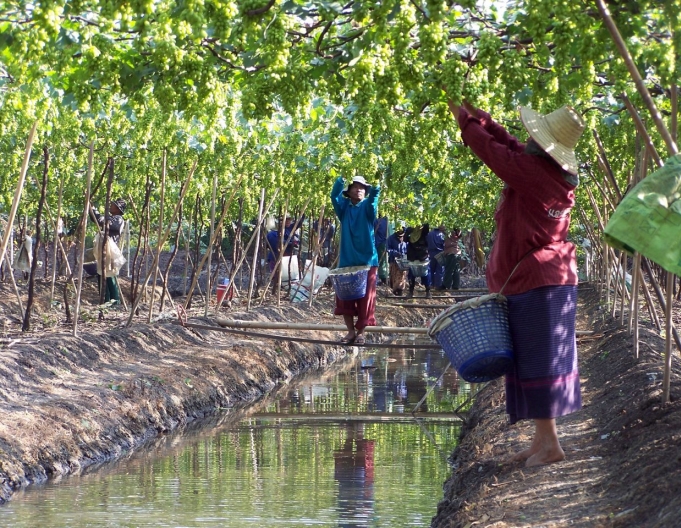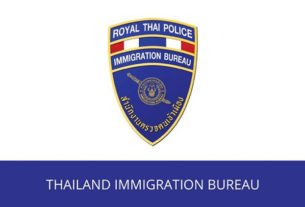Thai wine is gathering growing praise from world-renowned wine experts. Many tourists – including some who sign on as grape pickers – now include vineyards on their list of things to see in Thailand.
By Alexander Wischnewski
DIE WELT/Worldcrunch
 “Pungwan! Ya ded a gnun!“ That’s Thai for: “Pungwan! Leave the grapes alone!,“ and it’s what Worarat tells his elephant, Pungwan — all three to four tons of him. At 35-years-old, Pungwan is in his prime. Worarat is his driver, trainer and minder.
“Pungwan! Ya ded a gnun!“ That’s Thai for: “Pungwan! Leave the grapes alone!,“ and it’s what Worarat tells his elephant, Pungwan — all three to four tons of him. At 35-years-old, Pungwan is in his prime. Worarat is his driver, trainer and minder.
With care, Pungwan heaves his huge mass along a row between grape vines. Besides Worarat, he carries a tourist seated on a saddle chair. Tempted by the sweet grapes, Pungwan keeps swinging his trunk sideways, and Worarat again calls out “Ya ded a gnun.“ Pungwan makes do with some grass growing between the vines. The tour lasts 15 minutes.
Up until a few years ago, Pungwan‘ s ancestors ran wild in the Baan Khork Chang elephant corral located some 45 minutes by car from the resort of Hua Hin on the west coast of the Gulf of Thailand.
But since 2004, the largest wine producer in southeast Asia, Siam Winery, has been growing varieties like Colombard, Chenin Blanc, Muscat, Brunello, Shiraz (Syrah) and Tempranillo here on around 45 hectares of loamy, sandy, slate-filled soil. Together with the harvest from another property veined with small canals — Floating Vineyards, in Samut Sakhon near Bangkok – the firm produces nearly 400,000 bottles of wine per year, which amounts to two-thirds of Thai wine production.
Today, the last of the red grapes are being harvested. Within minutes, plastic crates are filled to over-flowing by women pickers whose faces are completely shielded by fabric to protect them from the sun. These table grapes that the elephants are so fond of will not be used to make fine wine: instead, they will provide the alcohol in “Spy”, a hugely popular Thai alcopop.
Looking around, the area looks almost Tuscan except for the palm trees and of course the elephants that continue to lumber through the vine rows carrying visitors.
A couple of things should be made clear at this juncture. One is that pictures of elephants working in Thai vineyards are made only to draw tourists. And two: Thai workers do not carry grapes in wooden barrels through the vineyards. That, like the idea of elephants helping out, is folklore. What actually happens is that the crates filled with grapes are trucked immediately to temperature-controlled presses and then the wine is stored in cool cellars to ferment. If this were not done, fermentation would get underway too early (we are after all nearly on the Equator here) to the detriment of the wine.
It’s best to find out anything beyond that bit of Thai Winemaking 101 directly from the Siam Winery and its multilingual staff. Kathrin Puff, for example, is a 32-year-old from Krefeld in Germany, with a degree in winegrowing from the RheinMain University of Applied Sciences (Geisenheim). She won experience — and recognition — as a vintner in Spain, Italy, and New Zealand before coming to Thailand where she’s been working for the Siam Winery since 2007.
Another linguist is Kim Wachtveitl, director of business development at Siam Winery Trading Plus. Son of Kurt Wachtveitl, the legendary former director of the Oriental Hotel in Bangkok, he presents the wines at the most prestigious wine fairs around the world.
The wines are already on the wine lists of almost all Thailand’s best hotels, such as the Hua Hin Hilton. ‘’You have to try this, it’s world class,” says director Boris Blobel pouring me a glass of 2008 Monsoon Valley, a red blend of Shiraz and Sangiovese. The Hua Hin vintage is rated 84/100 by American wine guru Robert Parker.
Thai wine pairs beautifully with different foods, as well. At the White Lotus, for example, which Tatler Magazine pronounces the best Chinese restaurant in Thailand, but also with European cuisine, such as a snack of olives, Parmesan and Parma ham that chef Rainer Schlinck of the Hua Hin Hilton pairs with a light white wine: spritzy, beautifully cooled Hua Hin Colombard that gets a Robert Parker rating of 87/100.
Join the harvest — in February
On the opposite bank of the Chao Phraya River sits the doyenne of Asian Grand Hotels: the world-famous Oriental. The hotel celebrated its 135th anniversary this past June. To mark the occasion, its German director, Jan Goessing, had two “Private Barrel Selections“ bottled with a drawing of the hotel on the label. These were a Monsoon Valley Colombard, and a Shiraz.
The hotel’s concierge can book all manner of different tours to Thai wine country. The harvest takes place between February and March. Tourists are welcome as pickers, and can register to help out. Bare vines are not something you see in Thai wine country; due to the warm climate they stay leafy and could theoretically yield two harvests annually, but they are pruned to prevent this because it would overstress the plants.
And rightly so, because too much yield would mean wine of lesser quality and hinder the kind of tasting experience offered by The Sala restaurant in Hua Hin. Hanna Oberauer, a young woman who works there as consultant and receives guests, recommends a small but superlative selection: with the White Shiraz, perhaps a pomelo salad, or tofu with garlic? With the red Shiraz she recommends deep-fried chicken with lemon grass; the duck with red curry and grapes would be better with the Monsoon Valley red blend, she says.
Back to ratings — Stuart Pigott, the British wine critic and author, is a fan of Monsoon Valley wines, and his opinion carries a lot of weight. Recently, he invited connoisseurs to a blind tasting in Berlin, where he lives, to compare ‘’classic vs. exotics.’’ He had become acquainted with – and liked — Hua Hin wines when he visited the vineyards.
I was invited to the tasting, and brought a Monsoon Valley Shiraz with me that I’d picked up in an Asian grocery store for 9.90 euros. The most expensive wine at the tasting was a Burgundy that cost 92.50 euros. The surprise was that the big-name French wine came in last. By contrast, the Shiraz from the Siam Winery was highly praised. Pigott’s take was: “Give the Thais a few more years of added experience and they will be producing world class wines.’’
Carlheinz Lietz, from Bingen in Germany, and his wife Sabine would be happy to hear that. They are owners of a fine wine store. He has a degree in nuclear chemistry, and has authored books about wine; she is a renowned gourmet coach and caterer. As wine scouts, they travel the world from Tahiti to Cuba and Lebanon tracking wines. In 2010, about to leave for a trip to Thailand, Carlheinz Lietz recalls, they were pleased that for once they would get a break from wine scouting by going somewhere where wine wasn’t produced.
Which is exactly what would have happened if they hadn’t see a German TV report on Hua Hin, and hadn’t been to the “Pro Wein” wine fair in Düsseldorf where Kim Wachtveitl was presenting Siam Winery wines. They immediately arranged to visit Hua Hin and today Lietz imports Monsoon Valley wines. “All you have to do,” he says, “is offer somebody a glass of Thai wine and in most cases after the first sip they forget any prejudices they may have had.”
Alexander Wischnewski’s trip to Thailand was supported by Hilton Hotels, the Thai tourism office and Thai Airways.
Source: http://www.worldcrunch.com/latest-secret-great-global-wine-thailand-just-follow-elephants/3412


